This is more of a demonstration than an activity using regular classroom window shades. The cross-sections shown have actually been carefully thought out to be useful for several levels of geologic history instruction.
To make the shades, it is important to first of all get permission from any administrator who will get ticked off at permanently defacing the shades!
Second, plan it out well. Think about what you want the shades to show. I started with index cards and sketches.
When drawing on the shades, be sure to account for the fact that the shades roll up and cover the drawing. It would be a shame to make a beautiful drawing on to have it too long to completely display. I also included surface features (trees and people) to show that these are exposures.
At the first level each shade makes a good sequence of events to solve. At this point, do not discuss the significance of the fossils or the heavy red line.
Shade #1 shows a sequence highlighting superposition with unconformities. (click the shades for a larger picture)
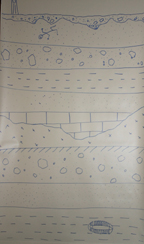
Shade #2 focuses on a fault and then an unconformity above it. This one is particularly useful because you rarely see sequences that have deposition after a fault. Students need to see how younger layers will continue to be deposited flat and level after a disturbance (folding, tilting and faulting). This is evident in the limestone layer that is thick on the left and thin on the right but flat on the top.
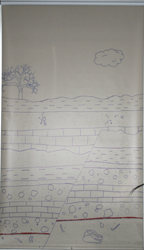
Shade #3 shows an igneous intrusion.
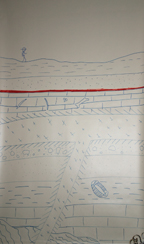
Shade #4 shows another intrusion but this time we don’t see the magma pipe coming from the bottom (also something that is rarely shown in these types of puzzles).
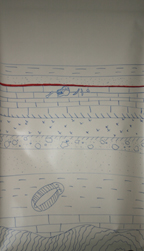
At the next level, the shades can be used to illustrate correlation. Each section matches well with the others but each section has some unique difference to make it a little less obvious and more challenging. Note that shades 3 & 4 exactly fit together but are made at different heights to illustrate uplift of one area. Only when the shades are offset do the layers re-align. It is particularly interesting to point out that in shade #1 there is a very big gap represented by the unconformity because this sequence shows both the oldest (trilobite) and youngest (human) fossils separated by only a few layers.
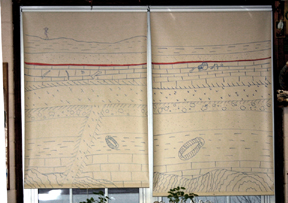
For the last level, the shades lead to a discussion of volcanic time markers and asteroid impacts. At first I say the line is like a volcanic marker and every layer just below it was formed at the same time. Finally, the true identity of the red line is revealed when you get to discuss asteroid impacts and the significance to the end of the dinosaurs.
